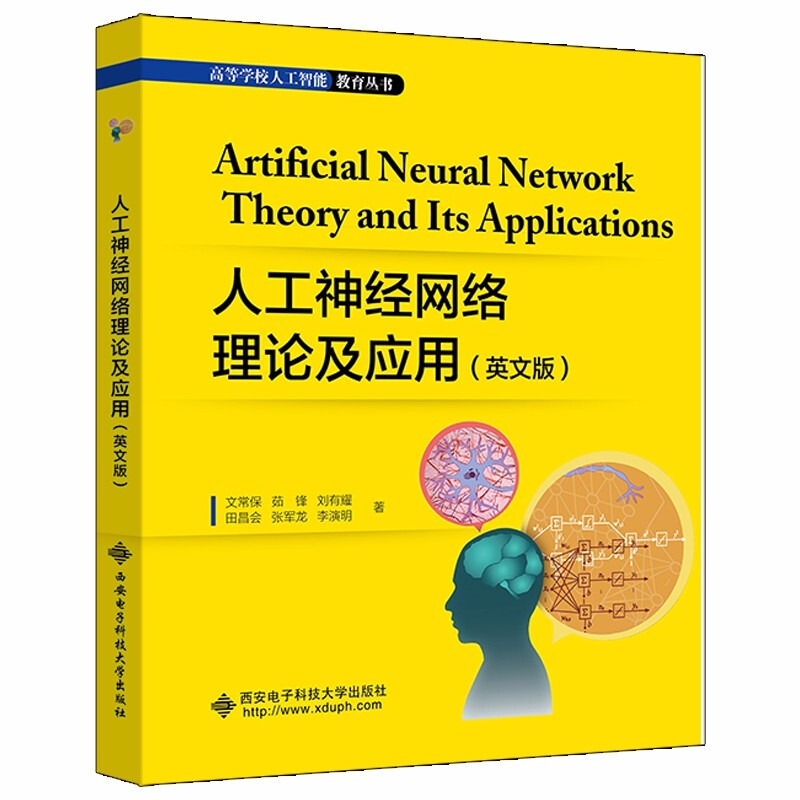- ISBN:9787560660356
- 装帧:一般胶版纸
- 册数:暂无
- 重量:暂无
- 开本:其他
- 页数:384
- 出版时间:2021-08-01
- 条形码:9787560660356 ; 978-7-5606-6035-6
本书特色
本书较全面地介绍了人工神经网络的相关理论及应用。全书包含三篇:人工神经网络基础、人工神经网络理论和人工神经网络实际应用。**篇包括生物神经网络理论基础、人工神经网络概述、人工神经网络数理基础。第二篇包括一些人工神经网络理论和几何概念,如感知器、BP神经网络、RBF神经网络、ADALINE神经网络、Hopfield神经网络、深度卷积神经网络、生成式对抗网络、Adaboost神经网络、SOFM神经网络。第三篇是基于Simulink的人工神经网络建模、基于GUI的运用Matlab和Python实现的人工神经网络设计等。 本书可作为相关专业本科学生和研究生教材,也可作为人工神经网络理论、实践及应用的工程技术人员的自学和参考用书。
内容简介
This book comprehensively and deeply introduces the artificial neural network theory and its application. The book consists of three sections: the foundation of neural network, artificial neural network theory, the design and practical application of neural network. First section mainly includes the theoretical basis of biological neural network, the review of artificial artificial neural network and the mathematical basis of artificial neural network. Second section includes some artificial neural network theory and algorithm, such as Perceptron, BP neural network, RBF neural network, Adaline neural network, Hopfield neural network, deep convolutional learning neural network, generative adversarial network, AdaBoost neural network, Elman neural network and SOFM neural network. Third section is the design and practical application of artificial neural network including the artificial neural network modeling based on Simulink, and artificial neural network design based on GUI using MATLAB and Python. This book can be used as a textbook for undergraduate and graduate students who are engaged in the theory,design and application of artificial neural network. It can also be used as a selfstudy and reference book for professional engineers.
目录
-

当代中国政府与政治(新编21世纪公共管理系列教材)
¥33.6¥48.0 -

落洼物语
¥8.7¥28.0 -

中国当代文学名篇选读
¥19.1¥53.0 -

中医基础理论
¥50.7¥59.0 -

北大人文课(平装)
¥13.9¥45.0 -

宪法-第二版
¥12.2¥29.0 -

当代中国政府与政治 第二版
¥57.8¥68.0 -

EPLAN电气设计
¥29.9¥39.8 -

闯进数学世界――探秘历史名题
¥21.3¥32.8 -

企业法务教程
¥34.8¥49.0 -

习近平新时代中国特色社会主义思想概论
¥18.2¥26.0 -

金融学
¥29.9¥49.0 -

计算机操作系统教程(第4版)(清华大学计算机系列教材)
¥31.9¥49.0 -

三国史
¥27.5¥50.0 -

陶瓷坯釉料制备技术/高职高专材料工程技术专业
¥37.4¥45.0 -

陶瓷工艺技术
¥41.7¥49.0 -

飞机总体设计
¥46.8¥78.0 -

陶瓷工艺学/焦宝祥
¥41.7¥49.0 -

古代汉语(第四册)
¥16.1¥35.0 -

编辑审稿实务教程
¥35.1¥45.0













